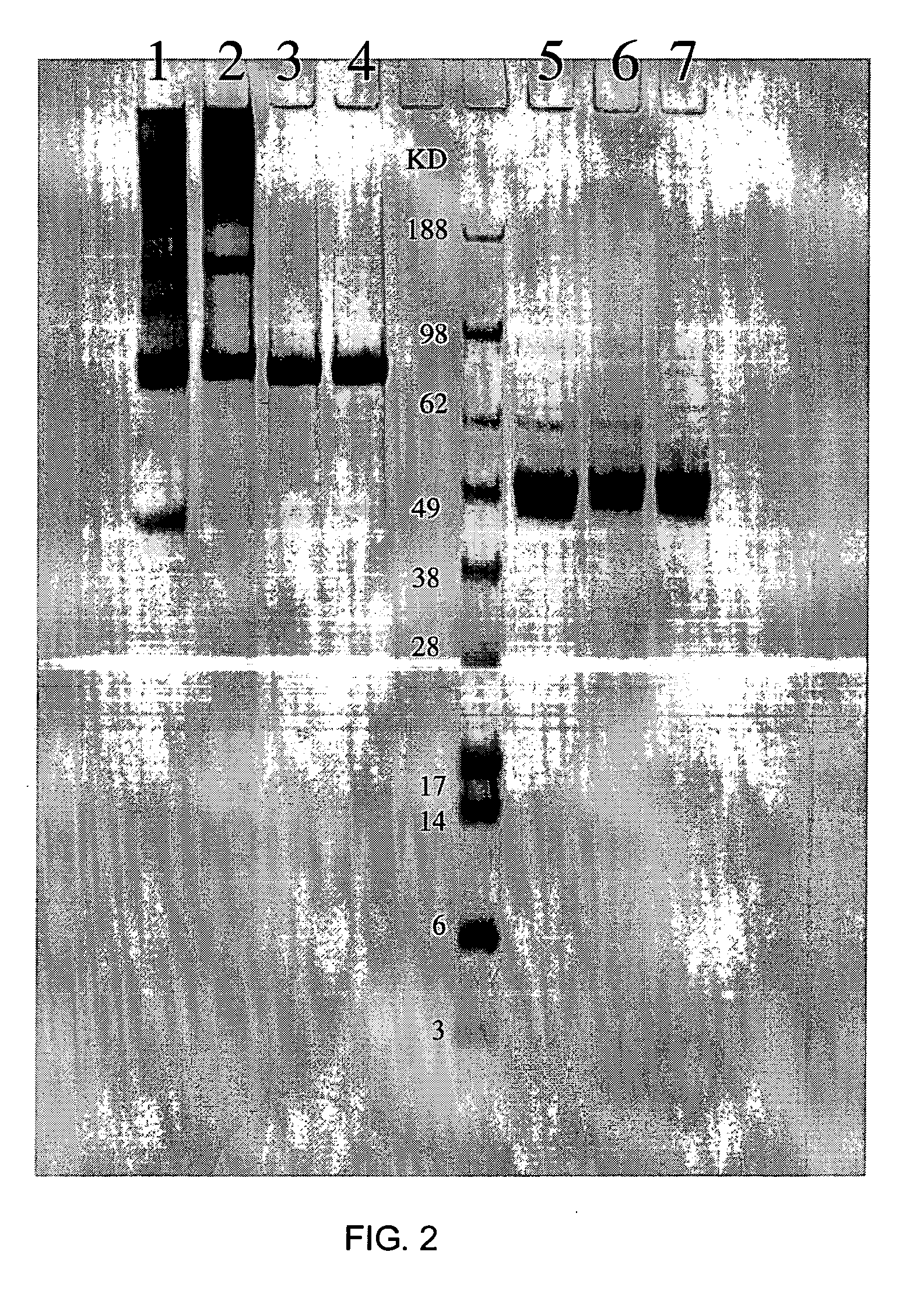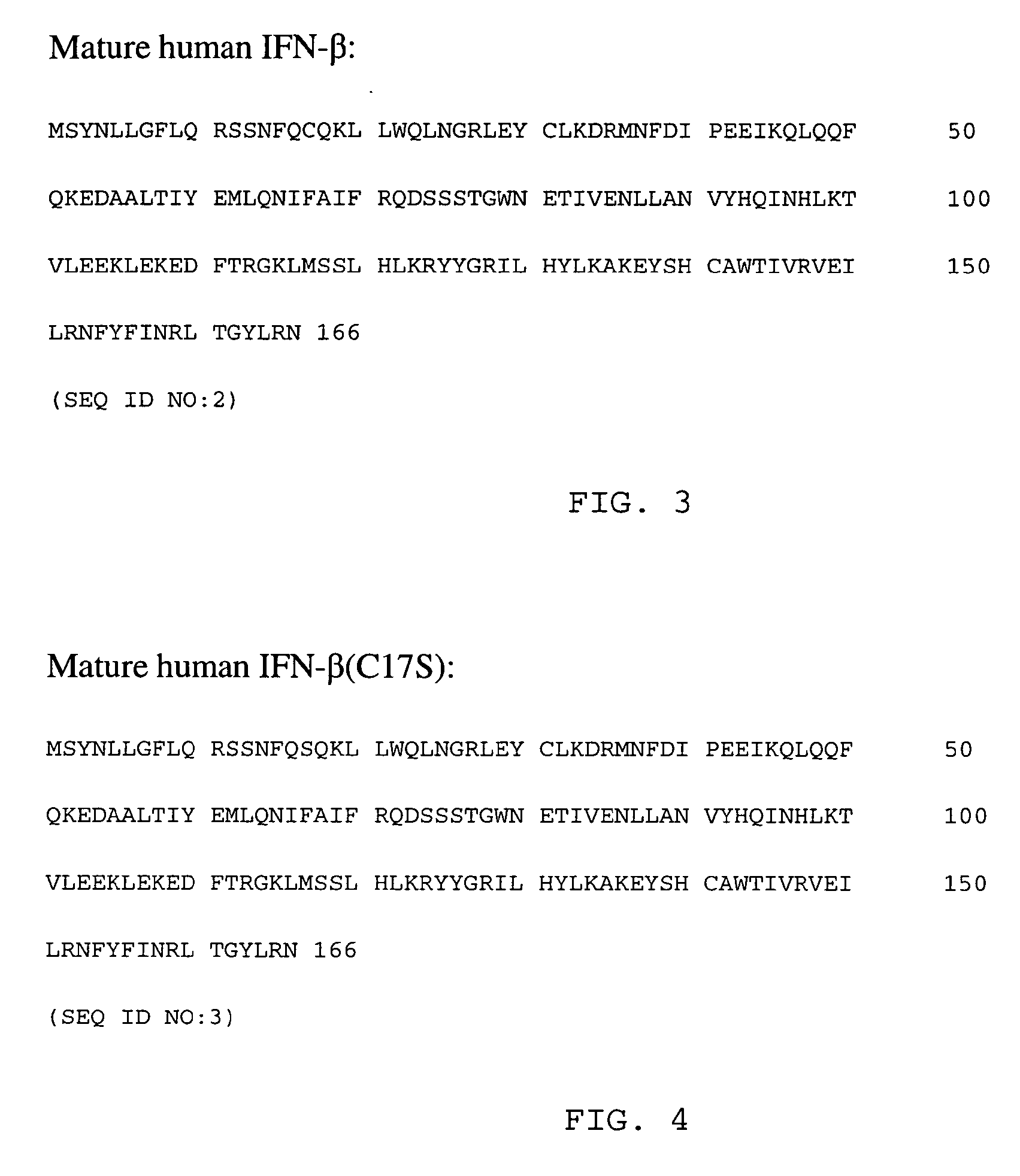Assembly and folding of fc-interferon-beta fusion proteins
a technology of interferon and fusion proteins, applied in the field of fusion proteins, can solve the problems of reducing the immunogenicity of the administered protein, toxic side effects, and affecting the expression of fc-interferonbeta fusion proteins, so as to prolong the circulating half-life, improve the biological properties, and increase the solubility
- Summary
- Abstract
- Description
- Claims
- Application Information
AI Technical Summary
Benefits of technology
Problems solved by technology
Method used
Image
Examples
example 1
Cloning of huFc-huInterferon-beta (huFc-IFN-β) and huFc-IFN-βsol Mutants
[0110]Human interferon β (IFN-β) cDNA was ordered from American Type Culture Collection (ATCC Number 31903). The sequence for the mature form was amplified by Polymerase Chain Reactions (PCR). The forward primer used in the amplification reactions was 5′ C CCG GGT ATG AGC TAC AAC TTG CTT (SEQ ID NO:45), where the sequence CCCGGGT encodes the carboxy terminus of the CH3 without the lysine codon, as well as the restriction endonuclease site SmaI CCCGGG (Lo et al., Protein Engineering (1998) 11:495), and the sequence in bold encodes the N-terminus of the mature IFN-β coding sequence. The reverse primer for this reaction was 5′ CTC GAG TCA GTT TCG GAG GTA ACC TGT (SEQ ID NO:46), where TCA is the anticodon of the translation stop codon, and CTCGAG is the restriction site Xho I. The amplified 450 bp PCR product was cloned into the pCRII vector (Invitrogen), and its sequence verified.
[0111]The SmaI-XhoI restriction fra...
example 2
Transfection and Expression of Fc-IFN-β Fusion Proteins
[0121]For rapid analysis of protein expression, the plasmid pdCs-huFc-IFN-β, pdCs-huFc-IFN-βsol(C17S) or other huFc fusion protein variants containing huIFN-β were introduced into human embryonic kidney HEK 293 cells (ATCC# CRL-1573) by transient transfection using lipofectamine (Invitrogen).
[0122]To obtain stably transfected clones which express huFc-IFN-βsol(C17S), for example, the appropriate plasmid DNA was introduced into the mouse myeloma NS / 0 cells by electroporation. NS / 0 cells were grown in Dulbecco's modified Eagle's medium supplemented with 10% heat-inactivated fetal bovine serum, 2 mM glutamine and penicillin / streptomycin. About 5×106 cells were washed once with PBS and resuspended in 0.5 ml PBS. 10 μg of linearized plasmid DNA were then incubated with the cells in a Gene Pulser Cuvette (0.4 cm electrode gap, BioRad) on ice for 10 min. Electroporation was performed using a Gene Pulser (BioRad, Hercules, Calif.) with ...
example 3
Characterization of huFc-IFN-β Fusion Proteins from Cell Supernatants
[0124]The huFc-IFN-β fusion proteins were subsequently captured from the medium for further analysis. For routine characterization by gel electrophoresis, the huFc-IFN-β fusion proteins secreted into the medium was captured on Protein A Sepharose beads (Repligen, Cambridge, Mass.) and then eluted by boiling the sample in protein sample buffer, with or without a reducing agent such as β-mercaptoethanol. The samples were analyzed by SDS-PAGE and the protein bands were visualized by Coomassie staining.
[0125]When huFc-IFN-β protein containing an immunoglobulin γ 4 isotype was analyzed by SDS-PAGE, it was found that the protein was not expressed in mammalian tissue culture cells as a uniform species. As shown in FIG. 2, under non-reducing conditions, in addition to a major band at 100 kDa which represented the huFc-IFN-β, multiple other bands were clearly visible, as well as an unresolved trail of higher molecular weigh...
PUM
| Property | Measurement | Unit |
|---|---|---|
| molecular weight | aaaaa | aaaaa |
| pH | aaaaa | aaaaa |
| pH | aaaaa | aaaaa |
Abstract
Description
Claims
Application Information
 Login to View More
Login to View More - R&D
- Intellectual Property
- Life Sciences
- Materials
- Tech Scout
- Unparalleled Data Quality
- Higher Quality Content
- 60% Fewer Hallucinations
Browse by: Latest US Patents, China's latest patents, Technical Efficacy Thesaurus, Application Domain, Technology Topic, Popular Technical Reports.
© 2025 PatSnap. All rights reserved.Legal|Privacy policy|Modern Slavery Act Transparency Statement|Sitemap|About US| Contact US: help@patsnap.com



